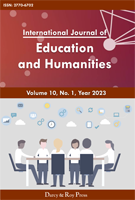The Impact of the Double Reduction Policy on the Academic Performance of Middle School Students
DOI:
https://doi.org/10.54097/bh4p1t22Keywords:
Double Reduction Policy, Middle School Students, Academic PerformanceAbstract
In the past decade or so, Chinese primary and secondary school students generally face tremendous academic pressure such as a variety of extracurricular training, heavy homework, and a variety of exams. According to Ren et al. (2016), primary and secondary school students in China need to spend more than three hours a day on homework and tuition in addition to seven to eight hours of classes. This is because when students finish the nine-year compulsory education level students need to enter different levels of high schools based on their final exam results (Xue and Makela, 2024). These problems seriously hinder the overall development and physical and mental health of primary and secondary school students. Therefore, in July 2021, China's Central Office issued the ‘Double Reduction’ policy, which aims to reduce the burden of homework and extracurricular tutoring for primary and secondary school students in China's compulsory education. It aims to reduce the burden of homework and extracurricular tutoring for primary and secondary school students in China's compulsory education, by reducing the amount of homework they have to do, and by reducing the variety of tutorials and home-school co-operation to address the heavy burden of schoolwork and stress on students. This reform has very important implications for the education sector in China. The policy will not only affect the education sector but also its related businesses. However, the impact of the ‘double reduction’ policy on students' performance is a major theoretical topic, and its objective impact needs to be analysed through rigorous empirical research.
Downloads
References
[1] Bingham, A. J., Dean, S., & Castillo, J. (2019). Qualitative comparative analysis in educational policy research: Procedures, processes, and possibilities. Methodological Innovations, 12(2). https://doi.org/10.1177/2059799119840982
[2] Cochran 1977 Sampling Techniques : Free download, borrow, and streaming : Internet Archive. (2023, January 9). Internet Archive. https://archive.org/details/cochran-1977-sampling-techniques/mode/2up?q=Causes+of+Sampling+Bias
[3] Evaluation to improve learning. (n.d.). Google Books. https://books.google.co.uk/books?redir_esc=y&hl=zh-CN&id= IshpmwM4YUIC&focus=searchwithinvolume&q=the+importance+of+objective+assessments+in+measuring+learning+outcomes.
[4] Evaluation to improve learning : Bloom, Benjamin S. (Benjamin Samuel), 1913-1999 : Free Download, Borrow, and Streaming : Internet Archive. (1981). Internet Archive. https://archive.org/details/evaluationtoimpr0000bloo?utm_source=chatgpt.com
[5] Graziotti, A. L., Hammond, J., Messinger, D. S., Bann, C. M., Miller‐Loncar, C., Twomey, J. E., Bursi, C., Woldt, E., Nelson, J. A., Fleischmann, D., & Alexander, B. (2012). Maintaining participation and momentum in longitudinal research involving High‐Risk families. Journal of Nursing Scholarship, 44(2), 120–126. https://doi.org/10.1111/j.1547-5069.2012.01439.x
[6] Groves, R. M. (2006). Nonresponse rates and nonresponse bias in household surveys. The Public Opinion Quarterly, 70(5), 646–675. https://www.jstor.org/stable/4124220
[7] Hein, G. (1991). Constructivist learning theory. In CECA (International Committee of Museum Educators) Conference, CECA (International Committee of Museum Educators) Conference [Conference-proceeding]. https://beta.edtechpolicy.org/AAASGW/Session2/const_inquiry_paper.pdf
[8] Howell, C. R., Su, W., Nassel, A. F., Agne, A. A., & Cherrington, A. L. (2020). Area based stratified random sampling using geospatial technology in a community-based survey. BMC Public Health, 20(1). https://doi.org/10.1186/s12889-020-09793-0
[9] Knott, E., Rao, A. H., Summers, K., & Teeger, C. (2022). Interviews in the social sciences. Nature Reviews Methods Primers, 2(1). https://doi.org/10.1038/s43586-022-00150-6
[10] O’Connor, C., & Joffe, H. (2020). Intercoder reliability in Qualitative Research: Debates and practical guidelines. International Journal of Qualitative Methods, 19. https://doi.org/10.1177/1609406919899220
[11] ONyumba, T., Wilson, K., Derrick, C. J., & Mukherjee, N. (2018). The use of focus group discussion methodology: Insights from two decades of application in conservation. Methods in Ecology and Evolution, 9(1), 20–32. https://doi.org/10.1111/2041-210x.12860
[12] Ren, H., Zhou, Z., Liu, W., Wang, X., & Yin, Z. (2016). Excessive homework, inadequate sleep, physical inactivity and screen viewing time are major contributors to high paediatric obesity. Acta Paediatrica, 106(1), 120–127. https://doi.org/10.1111/apa.13640
[13] Schmoker, 1999, North Central Regional Educational Laboratory, Fitzpatrick, M., Margolin, J., Learning Point Associates, Holcomb, 1999, & Sargent, 2003. (2004). Using data to guide school improvement. In Notes & Reflections. https://files.eric.ed.gov/fulltext/ED518630.pdf
[14] Sun, Y. (2024, September 23). Analyzing the impact of the “Double Reduction” policy on Student Well-Being and Academic performance in urban China. https://www.paradigmpress.org/rae/article/view/1308?utm_source=chatgpt.com
[15] Wang, D., Chen, X., Ma, Z., Liu, X., & Fan, F. (2022). Has the “Double Reduction” policy relieved stress? A follow-up study on Chinese adolescents. Child and Adolescent Psychiatry and Mental Health, 16(1). https://doi.org/10.1186/s13034-022-00530-6
[16] Wei, W. (2024). The impact of the double reduction policy on the academic achievements of Chinese secondary school students in mathematics: A case study of Yuncheng city, Shanxi province. SHS Web of Conferences, 187, 02004. https://doi.org/10.1051/shsconf/202418702004
[17] Xu, W., & Zammit, K. (2020). Applying Thematic Analysis to Education: A hybrid approach to interpreting data in practitioner research. International Journal of Qualitative Methods, 19. https://doi.org/10.1177/1609406920918810
[18] Xue, D. Z. &. X. L. &. J. (2015). Education Inequality between Rural and Urban Areas of the People’s Republic of China, Migrants’ Children Education, and Some Implications. ideas.repec.org. https://ideas.repec.org/a/tpr/adbadr/v31y2015i2p196-224.html
[19] Xue, E., & Li, J. (2022). What is the value essence of “double reduction” (Shuang Jian) policy in China? A policy narrative perspective. Educational Philosophy and Theory, 55(7), 787–796. https://doi.org/10.1080/00131857.2022.2040481
[20] Xue, X., & Makela, C. (2024). Double reduction educational policy: Impacts on grades 1-9 compulsory education in China. International Journal of Chinese Education, 13(2). https://doi.org/10.1177/2212585x241270236
[21] Yuan, J. (2024). Exploring the impact of the ‘Double Reduction’ policy on academic performance and comprehensive abilities. Journal of Education and Educational Research, 7(1), 153–156. https://doi.org/10.54097/zjcz8z60
Downloads
Published
Issue
Section
License
Copyright (c) 2025 International Journal of Education and Humanities

This work is licensed under a Creative Commons Attribution 4.0 International License.

















